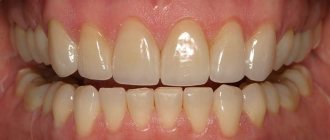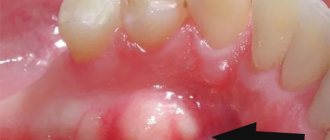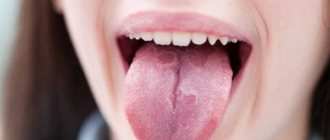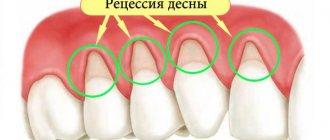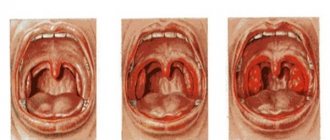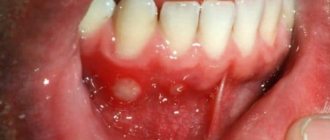September 11, 2017
Recession or loss of gums is not only an aesthetic problem. Due to the fact that the gums shrink in size, the neck and root of the tooth are exposed. Physiologically, they should be covered with soft mucous membrane and therefore the enamel in these areas of the tooth is thinner - in the absence of gums, the teeth become sensitive. In addition, they are subject to increased attack by bacteria (usually the enamel protects the internal dental tissues from external influences). The result is pain, rapid development of caries, pulpitis and other diseases.
Gum recession
Editorial UltraSmile . ru I hastened to find out what gum recession is, why this problem occurs, and whether it is possible to restore your smile to its former beauty.
Symptoms of gum recession
Gum recession is usually not accompanied by redness, swelling, or bleeding of the gums. On the contrary, the gums become whitish and gradually shrink in volume, which leads to exposure and lengthening of the teeth. As a result, a violation of the aesthetics of the smile occurs, the teeth become more sensitive to external irritants: cold or hot foods, and pain may occur when brushing or biting on hard foods. In addition, gum recession is accompanied by the formation of dark carious spots on the exposed areas of the teeth, which are no longer covered by protective gum.
Symptoms of gum recession
Why gums recede: reasons
A disease whose main symptom is gum recession is periodontal disease . It occurs due to disruption of metabolic processes between mucosal cells. Due to a lack of nutrients (for example, with diabetes, other endocrine, immune or disorders of the body's cardiovascular system), the gums noticeably decrease in size. Another reason is an advanced inflammatory process of the gums - gingivitis and periodontitis (in rare cases, periodontal disease can occur as a consequence of untreated periodontitis).
Periodontal disease
Gum recession is very often observed in older people, since due to the physiological characteristics of the body there is a reduction in tissue volume.
Among the anatomical causes of gum loss is a too short labial frenulum (the thin mucous membrane that connects the inside of the lips and the two front incisors on both jaws). The frenulum is stretched, which leads to a change in the position of the gums. Too thin bone tissue and at the same time large tooth roots can also lead to the appearance of a mucosal defect.
Injuries also contribute to the reduction of gum volume: malocclusion, bad habits (for example, biting the tip of a pen), wearing orthodontic appliances or dentures - all this leads to constant pressure on the gums, due to which the nutritional process in them is disrupted and the tissue atrophies.
Treatment
In most cases, mild gum recession does not require treatment. Dentists can advise on prevention and offer gum monitoring. Teaching effective but gentle brushing is an effective early intervention.
For people who truly need treatment, there are several options:
- Desensitizers, varnishes and dentin binders: These agents are aimed at reducing the sensitivity of the exposed tooth root. Desensitizers treat nerve symptoms and help maintain oral hygiene by making it easier to brush sensitive teeth.
- Composite restoration: The dentist uses tooth-colored composite resins to coat the surface of the tooth root. They can also cover black spaces between teeth, as shown in these before-and-after photos from the British Dental Journal.
- Pink Porcelain or Composite: This material is the same pink color as the gums and can be used to fill voids where gums have receded.
- Removable Gum Veneers: Typically acrylic or silicone, they artificially replace much of the missing gum tissue due to recession.
- Orthodontics: These include procedures that slowly move the position of teeth over an extended period of time. This repositioning can correct the gum margin and make it easier to keep your teeth clean.
- Surgery: The dental surgeon transplants tissue from another location in the mouth and the tissue heals after gum recession. Usually the patient only needs this to treat severely receding gums.
Gum loss: 5 treatment methods
Treatment of gum recession is carried out in a comprehensive manner: first of all, it is necessary to eliminate the cause of the problem - treat a concomitant disease of the body, correct the bite, adjust the shape of the prosthesis, or give up bad habits. At the same time, the gum pockets are cleaned - plaque and hard stone are removed from under the gums. In the early stages, drug treatment is possible, but the position of the gum itself can only be corrected surgically.
Flap surgery
In essence, this is a tissue transplantation from another zone where there is a lot of donor material. For example, from the area of the hard palate or gums not affected by recession. The surgical operation is performed under local anesthesia and allows you to restore the soft mucosa in the area of one or many teeth in a row. This is the main method of treatment, which, however, also has some disadvantages: after treatment, slight discomfort in the donor area, as well as inflammation of the injured tissues, may occur. In addition, the sewn flap may not take root correctly and is not entirely aesthetically pleasing. However, if you choose a professional doctor, follow postoperative recommendations, and be careful with wounds, treatment will allow you to correct the level of the gums without negative consequences.
Flap gum surgery
Video of flap surgery on gums
Use of protective membranes
This method is relevant only if there is a slight loss of gums. It is carried out as follows: the doctor peels off the gum, installs a hard membrane, which promotes the growth of the mucous membrane. At the same time, drug therapy is prescribed to restore nutrition to tissue cells. After some time, the membranes either dissolve on their own (resorbable) or require removal (non-resorbable).
Use of protective membranes
Use of fibrin membranes
Fibrin is a protein obtained from blood plasma. In our body it blocks the inflammatory process. Today scientists know how to obtain it artificially and use it for medical purposes. In the case of loss of gum level, plasma is obtained from the patient’s own blood by processing in a centrifuge, from which a fibrin membrane is created. During the operation, the doctor implants donor material, having previously peeled off a small area of his own gum. The advantage of the technology is that the fibrin membrane is guaranteed to take root; however, this technique is quite expensive.
Collagen treatment
Collagen is also a protein that is now actively used in cosmetology to renew and rejuvenate facial skin. The introduction of collagen into the gums allows you to restore the volume of the mucous membrane, cover the exposed part of the tooth, and improve the aesthetics of your smile, but only in case of slight loss of soft tissue.
Collagen injections
Physiotherapy
Good results in the treatment of gum diseases are achieved by physical procedures - exposure to magnetic current, ultraviolet light or laser. The procedures allow you to restore the natural functions of tissues, saturate the mucosal cells with nutrients, which is especially important in the initial stages of gum atrophy and after surgery.
Treatment of exposed tooth neck at home
If there is gum recession, then it can be treated with folk remedies. They are prepared from oils or herbs purchased from pharmacies.
- Rubbing the gums and roots of the teeth with aloe juice will relieve inflammation caused by periodontitis or gingivitis.
- Rinsing the mouth with decoctions of chamomile, sage, yarrow, and calendula will have an antiseptic effect and prevent the development of pathogenic microflora.
- Compresses with essential oils of spruce and fir reduce pain and bleeding of gums in the inflamed area.
- Gum massage will improve blood flow and accelerate tissue cell regeneration. To implement this, it is enough to purchase a toothbrush with soft bristles, and massage the soft tissues with it in a circular motion from the molars to the incisors. You can also massage with your fingers. Light pressure stimulates blood flow to the tissues. They are useful not only for recession, but also for inflammatory diseases and tissue atrophy.
Traditional methods of treating tooth neck exposure at home should be combined with conservative methods, and also be agreed upon with the dentist.
A few words about prevention
Dentists never tire of reminding that the best way to protect yourself from treatment is prevention. As for gum recession, there are not many options: you just need to treat inflammation of the mucous membranes in a timely manner (if redness and bleeding appear, immediately contact a specialist), and regularly remove plaque and tartar. It is very important to choose the right hygiene products - it is not recommended to use toothbrushes that are too hard, as they lead to traumatic gum recession.
Oral hygiene
If you notice any symptoms, do not delay going to the dentist, because treatment at an early stage will be simpler and less expensive.
Notice
: Undefined variable: post_id in
/home/c/ch75405/public_html/wp-content/themes/UltraSmile/single-item.php
on line
45 Notice
: Undefined variable: full in
/home/c/ch75405/public_html/wp-content /themes/UltraSmile/single-item.php
on line
46
Rate this article:
( 3 ratings, average: 5.00 out of 5)
gum disease
Consulting specialist
Ozhegina Natalya Mikhailovna
Doctor rating: 9.3 out of 10 (4) Specialization: Dentist-therapist, hygienist Experience: 10 years
Traditional methods of gum restoration
Restoration of physiological processes in the gums using alternative medicine is often combined with massage of the affected area. It must be taken into account that if there is sensitivity in the teeth and mucous tissues, this intervention is contraindicated. Baking soda and propolis tincture are mainly used.
An ointment is prepared from soda: 3 tbsp. l. soda and 1 tsp. boiled water. The composition is rubbed between the fingers and applied to the affected area with light massaging movements with a soft toothbrush. After rubbing, the mouth should be rinsed with a solution with an anti-inflammatory effect (Rotokan, chamomile infusion).
Propolis is used mixed with alcohol: 40 g. the plants are mixed with 100 ml of 70% alcohol. The tincture should be stored for no more than 10 days in a dark place; shake before use. When the storage period expires, the solution must be filtered. Use the medicine as a rinse for 1 month every 3 months. The effect is observed after the third week of use.
Gum augmentation to eliminate recession using surgical and conservative treatment methods has its own indications and limitations. In order for tissue restoration to be optimal in terms of aesthetic and functional value, before choosing the method of intervention, the level of exposure, the presence of diseases of the oral cavity and somatics are taken into account.
The best method of preventing this pathology is proper oral hygiene: it is necessary not only to clean the teeth and interdental spaces, but also to massage the gum area to improve blood flow.
Author: Evgenia Korotaeva, dentist, especially for Karies.pro
Comments
A gum flap can be used for both local and generalized forms, provided that the gums have sufficient volume. Transplantation of a flap extracted from the tissue membrane of the palate. This method is not preferred because the palatal tissues may not heal well and do not always match in color.
lim (09/16/2017 at 01:49 pm) Reply to comment
If the displacement is local and there is enough material in the tissues around it, a lateral flap is used from the areas adjacent to the defect site. This method is good because, thanks to the close arrangement of fabrics, it is possible to achieve a perfect color match. A gum flap can be used for both local and generalized forms, provided that the gums have sufficient volume.
n0mini (09/19/2017 at 01:37 pm) Reply to comment
